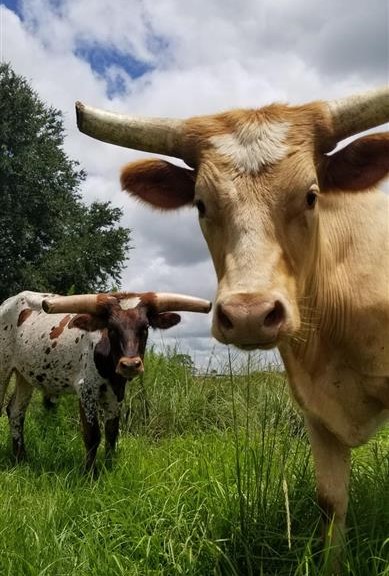
Author: Lydia Landau
You might not look twice at this small group of ten steers at Archbold Biological Station’s Buck Island Ranch. This motley crew of young steers are mostly Florida Cracker Cattle, except one Watusi—discernible by his massive horns compared to the rest and named “Bunny” for his sweet demeanor. One expects to see cattle on a ranch, but these steers have a unique job: they are grazing for science.
Archbold’s Agroecology Research Lab at Buck Island Ranch is working with the University of Florida on a new experiment to better understand how different rainfall scenarios and high vs. low intensity grazing combine to impact pasture health. “Most of our previous experiments have compared ungrazed vs. grazed treatments and did not attempt to experimentally implement different grazing intensities,” explains Dr. Betsey Boughton, Program Director of the Agroecology Lab. “Having controlled, quantitative grazing will give us a clearer idea on the effect of grazing on pasture grasses and soils,” she adds.
Lydia Landau is a research assistant in the Agroecology Lab and is managing this experiment and the ten steers. “The trick with this highly-controlled grazing approach is that it needs to be consistent across all experimental areas,” she explains. The initial plan was to simply leave the gates open to the fenced-off experimental areas and let the regular ranch cattle come in and graze as they pleased, “but the problem with that approach,” Landau says, “is that we would have a very difficult time keeping grazing consistent. One group of cows might never venture into an experimental area while another group on a different part of the ranch might graze non-stop in their experimental area for a full week. That made the data much harder to interpret.” The solution to this problem was to get a small, dedicated research herd that would be managed by the Agroecology Lab. This herd could graze inside the experimental areas and be moved easily between areas on a set schedule.
“I’m really excited to have these research steers so that we can graze our rainfall manipulation experiment with real cattle. Other studies like this have used clipping or mowing to simulate grazing, but we know that is not a good representation of what grazing is really like. In reality, when cattle graze they are quite picky, so grazing has a different impact than a lawn mower,” adds Boughton.
To build the herd, Buck Island Ranch’s Operation and Research Resource Coordinator, Laurent Lollis, suggested bringing in “retired” roping steers and he helped Landau source them from another Florida ranch. “The idea was that roping steers have had more consistent human contact and are more used to going through gates, loading onto a trailer, being held in smaller areas, etc.—all of which will come in handy for the very hands-on management we will need to do with them,” explains Landau. Although ‘The Boys’—as the Agroecology Lab has lovingly nicknamed them—were a little shy at first, “they were all literally eating out of the palms of our hands within a few weeks,” says Flynn Hibbs, an Agroecology intern working closely with Landau on this project. Food is the main factor in their training, and they are hand-fed a small amount of grain several days a week. “The bottom line is that they need to be safe and predictable—friendly but not pushy—so that anyone, regardless of livestock experience, can be trained to work with them,” Landau says. Landau worked as a farmhand on dairy and meat farms and ranches for five years before going back to school to finish her bachelor’s degree and starting a new career as a scientist. “It was so bittersweet to leave farming,” she says. “When I transitioned to science, I never expected I’d be managing a small herd again one day! It’s been a really pleasant surprise.”
The steers arrived in July and have been getting acclimated and trained. They will begin their research grazing in February. The hope is that this experiment will continue for several years, and The Boys will be used for other targeted grazing experiments in the future. “The research steers open up a new frontier for us so that we can impose different grazing treatments in our work,” says Boughton.

